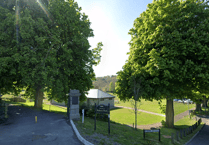ANOTHER chilly start to a dry, autumnal day did not put off 20 Newton Abbot A walkers heading out. We were bound for Uffculme, in east Devon below the Blackdown Hills, to be led around a 9.5-mile route by voluntary walk leader Rose Rashley, writes Norman Maudsley.
Rose explained we would encounter the River Culm numerous times during the day as we carried out a number of loops into the surrounding countryside.
Starting from a road bridge crossing the River Culm, which gathers its water from the Blackdown Hills before passing through Uffculme, we walked down the left bank to a weir where water used to power a water wheel which ran the machinery operating in the woollen mills.
From the 16th century, Uffculme was a significant part of the West Country wool industry, reaching its height in the middle of the 18th century, when large quantities of Uffculme’s serges were exported to Holland by nearby Tiverton merchants.
Coldharbour Mill, the last surviving woollen mill to operate in the village, was built in 1799. In 1983 it re-opened as a working museum, best viewed on one of its steam days when you are able to see the machinery fully operating.
While we walked down the river, the day had warmed up and we were seeing the countryside at its best. Finding a suitable spot by the river, we enjoyed our morning coffee break sitting in the sun, one of the simple joys of walking with a friendly group of like-minded ramblers.
Setting off, we soon reached a meadow with an unusual stone gateway which would have been more in-keeping on Dartmoor. On closer examination we found it held a poem written about the beauty of the area.
Moving on, we visited places with names including Hunkin Wood, Craddock, Yondercott and Slow Jacks as we wound our way along Rose’s route.
One of the paths utilised the trackbed of the Old Culm Valley Light Railway, which opened in 1876 and closed in 1975.
Locals and visitors alike can use this route to visit St Mary’s Parish Church. People have worshipped here since the 12th century although most of the present architecture is medieval and Victorian.
The church is famous in Devon as having the longest rood screen, built circa 1450. At 67ft long, it has been partially restored to show the original colours of brilliant red and gold.
From the highest section of the walk we were able to view the full length of the village, spread as it is along the Culm Valley. An old red brick building, built in 1858 and originally the Uffculme Brewery, stands in the high street. It is now used for a community hub and business with an impressive roof garden.
Arriving back at the cars we thanked Rose for guiding the group around her winding course which had been enjoyed by all participants.
Before heading home four of us visited the cafe at the Old Well Garden Centre where copious cups of tea washed down some very good cake, justified as good for our body and soul.
On Thursday evening I attended the 38th Newton Abbot Ramblers’ annual meeting. Mike Strickland ran the meeting with his usual well-prepared notes in his hand, thanking walk leaders and supporters for their joint efforts in making the club as active as it is, with its wide range of social events.
Some of the loyal committee members were stepping down: Diane Baker, footpath officer; Graham James, the programme secretary; Allan, who had done sterling work with the group’s website, and Eddy Lee, social secretary, who has held many roles over the years.
The best part of the evening was a presention by Arthur Hart, 92 years young. He expertly talked about his holidays in the 1980s, taking us to exotic destinations including the Arctic, Middle East and South America. I can only hope I can still be going out to give talks when I am 92.
On Friday I was out to Totnes to raise funds for the Devon Air Ambulance Trust by giving an illustrated talk on my trekking trip in Peru to Machu Picchu and the Inca ruins.
On Saturday, with the weather looking good, I accompanied a partially-sighted friend to walk to the west of Newton Abbot through lovely countryside, and on the way home call in for a surprise carvery lunch.
If you are ever at a loose end, make contact with a deserving person and get out in the sun doing something together.
On Sunday, 11 Teignmouth and Dawlish walkers met up at Hallsands to complete a nine-mile walk on the South West Coastal Path as the outward route, followed by an inland route back.
After a glorious sunny Saturday it came as wake-up call to find autumn was now battering the group with strong winds.
We experienced high winds and wild seas lashing the coast. This particular section of the Devon coastline fights an ongoing struggle with the sea. The nature of the bay means it often receives the full force of winter storms, and two villages have been lost to the sea – Strete Undercliffe towards the end of the 18th century and Hallsands in 1917.
One of the causes of the freak weather conditions is an area of sea bed known as the Skerries, from the Old Norse skes (meaning rocky reef).
Heading south along the coastal path we passed rock formations such as Wilson Rock, Lobster Rock and Shoelodge Reef giving a good view of the Start Point Lighthouse.
Today our voluntary leader Pauline made the right decision in the interests of group safety not to follow the coastal path up to the lighthouse, due to the strong, blustery winds. We would follow an inland path to Great Mattiscombe sands.
Sheltering from high winds we enjoyed our morning coffee break with views along the coast. We could see an ancient feature reminding me of my recent climbs up volcanoes. The two pointed rocks on the headland looking like rhino’s horns, were made of dolomite, the hard central core rock of extinct volcanoes, and many thousands of years old.




